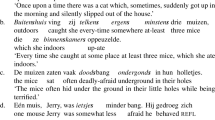Abstract
The Hebrew verbal gerund is a construction used mainly as a temporal adverb. Its surface form consists of the following sequence of elements (where Vinf is an infinitival verb form and XP is a complement of the verb): P - Vinf - Subj - XP. The main claim of this paper is that the verbal gerund is a clausal structure with an INFL node specified as [-Tense]. As a VSO clausal structure, the verbal gerund is an exceptional phenomenon in an otherwise SVO language. This and other idiosyncratic properties of the construction are explained on the basis of some properties of the initial element. It is argued that the initial preposition is a complementizer and that the surface word order of a verbal gerund is derived by two successive applications of head movement, from V to I and from I to C. In addition to word order, the proposed analysis makes possible an explanation of other properties of the verbal gerund, such as the obligatoriness of an overt subject and the impossibility of negation.
Similar content being viewed by others
References
Abney, Steven: 1987, The English Noun Phrase in Its Sentential Aspect, doctoral dissertation, MIT, Cambridge, Massachusetts.
Baker, Mark: 1988, Incorporation: A Theory of Grammatical Function Changing, University of Chicago Press, Chicago.
Berman, Ruth: 1978, Modern Hebrew Structure, University Publishing Projects, Tel Aviv.
Borer, Hagit: 1984, Parametric Syntax, Foris, Dordrecht.
Chomsky, Noam: 1986a, Knowledge of Language, Praeger, New York.
Chomsky, Noam: 1986b, Barriers, MIT Press, Cambridge, Massachusetts.
Chomsky, Noam: 1991, ‘Some Notes on the Economy of Derivation and Representation’, in Robert Freidin (ed.), Principles and Parameters in Comparative Grammar, MIT Press, Cambridge, Massachusetts, pp. 417–454.
Emonds, Joseph: 1985, A Unified Theory of Grammatical Categories, Foris, Dordrecht.
Gesenius, W: 1920, Hebrew Grammar, Oxford University Press, Oxford.
Glinert, Luis: 1989, The Grammar of Modern Hebrew, Cambridge University Press.
Hazout, Ilan: 1990, Verbal Nouns: Theta Theoretic Studies in Hebrew and Arabic, Doctoral dissertation, University of Massachusetts, Amherst.
Hazout, Ilan: to appear, ‘Action Nominalizations and the Lexicalist Hypothesis’, NLLT.
Larson, Richard: 1988, ‘On the Double Object Construction’, Linguistic Inquiry 19, 335–391.
Milsark, Gary L.: 1988, ‘Singl-Ing’, Linguistic Inquiry 19, 611–634.
Pollock, Jean-Yves: 1989, ‘Verb Movement, Universal Grammar, and the Structure of IP’, Linguistic Inquiry 20, 365–424.
Rizzi, Luigi: 1986, ‘Null Objects in Italian and the Theory of pro’, Linguistic Inquiry 17, 501–558.
Rizzi, Luigi: 1990, Relativized Minimality, MIT Press, Cambridge, Massachusetts.
Shlonsky, Ur: 1988, ‘Complementizer-Cliticization in Hebrew and the Empty Category Principle’, NLLT 6, 191–206.
Shlonsky, Ur: 1990, ‘pro in Hebrew Subject Inversion’, Linguistic Inquiry 21, 263–275.
Williams, Edwin: 1980, ‘Predication’, Linguistic Inquiry 11, 203–38.
Williams, Edwin: 1989, ‘The Anaphoric Nature of Theta Roles’, Linguistic Inquiry 20, 425–456.
Zanuttini, Raffaela: 1990, ‘On the Relevance of Tense for Sentential Negation’, manuscript, University of Pennsylvania.
Author information
Authors and Affiliations
Additional information
I am grateful to Roger Higgins and Edwin Williams for discussions and useful suggestions at earlier stages of my work on this topic. The comments of an NLLT reviewer led to considerable improvements. Carol Georgopoulos has been most helpful in both editorial and substantial matters.
Rights and permissions
About this article
Cite this article
Hazout, I. The verbal gerund in modern Hebrew. Nat Lang Linguist Theory 10, 523–553 (1992). https://doi.org/10.1007/BF00133329
Received:
Revised:
Issue Date:
DOI: https://doi.org/10.1007/BF00133329




